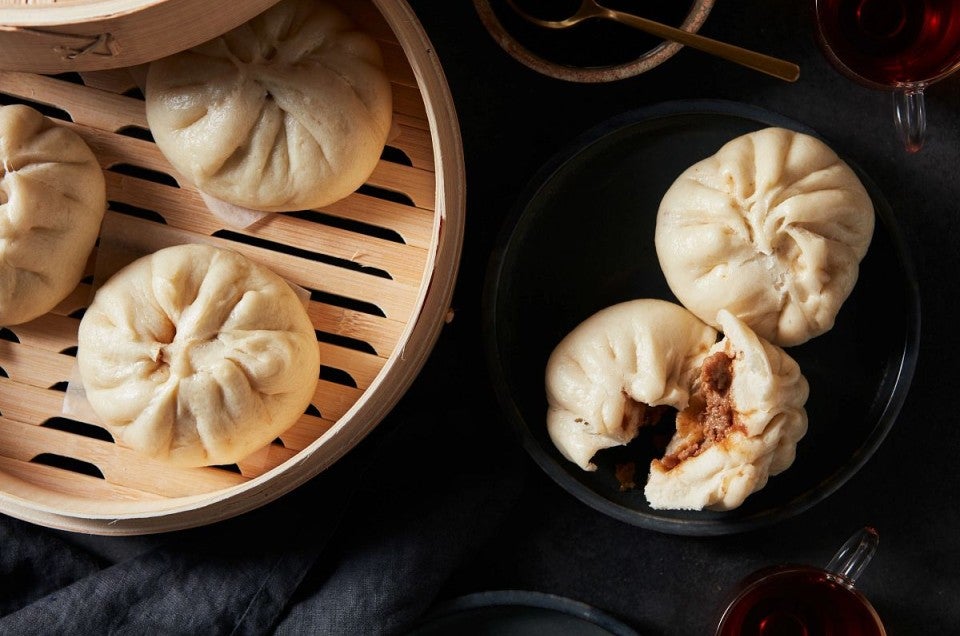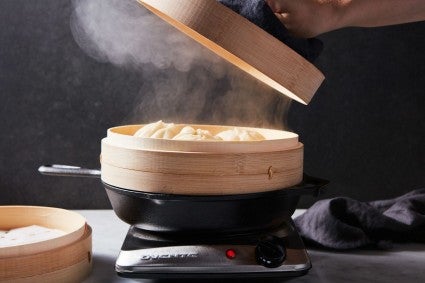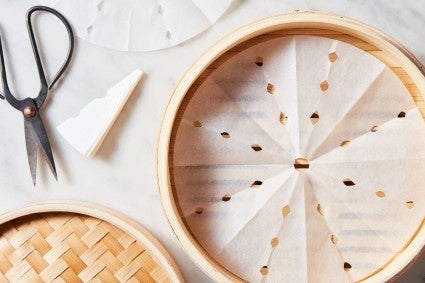Everything you need to know to make steamed buns
From the best setup to advice on keeping your steamer in top shape, here's your guide to steaming.


Long before I learned how to turn on an oven, I was taught how to steam. In my Taiwanese household, steaming has always been a constant. My mother used to keep a pot of braised pork belly simmering in an electric steamer all day. For lunch, my grandmother would steam a whole fish topped with piquant ribbons of scallions and sharp ginger, kissed with a gentle hit of soy sauce. These days, I especially love churning out delicate baos and dumplings in my two-tiered bamboo steamer; there’s something immensely comforting in seeing my small kitchen enveloped in a cloud of steam.
An underappreciated tool in Western kitchens, a steamer is a versatile piece of equipment that every cook and baker should have. It can be used to reheat leftovers or soften vegetables, and it’s the secret to a soft and fluffy steamed bun. Here’s how to get started:

For buns, dumplings, or any steamed pastry, a bamboo steamer is the way to go. A classic and affordable pick, bamboo is great because it absorbs condensation, preventing the food from becoming soggy due to dripping water. This is especially important for buns; if too much water falls on them during the steaming process, they can turn unpleasantly wet.
A 10" bamboo steamer is the standard size for the average home cook. To use, add about 1" to 1 1/2" water to a 14" wok or a large pot or pan. Bring it to a rolling boil, then nestle the covered bamboo steamer with the food inside over the water. The bottom rim of the steamer should be submerged in water at all times or else it will start to char. Make sure the floor of the steamer does not touch the water, or else the food will get drenched. Depending on how long your steam time is, you might have to replenish the water from time to time. I like to keep a kettle of boiling water on the side for a quick top-off.

While I’m partial to the bamboo-steamer-on-a-wok setup because of its inherent simplicity, don’t feel like that is your only option. A stainless-steel steamer on top of a large pot will totally do the trick; just mind the lid. Because stainless steel doesn’t absorb water the way bamboo does, you should tightly wrap the steamer lid with a large piece of cheesecloth or a clean, dry kitchen towel, tying ends around the lid’s handle. The cloth absorbs condensation and keeps water droplets from dripping onto the food. The last thing anyone wants is a soggy bun!
A single round piece of perforated parchment paper that fits snugly into the steamer is the quickest way to line the basket — the holes allow the steam to circulate through, and the parchment paper prevents the buns from sticking to the bamboo. But since steamer sizes vary wildly depending on the brand, placing each individual bun on parchment paper squares is another foolproof way to get the job done.
If you don’t have access to any of the above, you can use lettuce leaves (crack their spines so they lie flat) or just make your own perforated parchment. To do so, roll out a large sheet of parchment paper. Cut out rounds sized to your steamer, then fold it a couple of times and make small incisions on the sides at random with scissors — like you’re cutting out a paper snowflake. Unfold and line your steamer basket with the paper.

When steaming buns, always bring the water in the wok or large pot to a rapid boil first. Carefully lower the steamer into the wok or pot and then adjust the heat depending on the recipe.
Make sure to leave plenty of space — at least 1" — between the buns; yeasted buns will expand as they steam and will stick to one another if they’re overcrowded. The beauty of a bamboo steamer is that you can buy multiples in the same size and stack them high, so get a couple of tiers and bulk steam your buns in one go rather than spending time steaming in multiple batches.
While steaming, follow the time indicated in the recipe, and resist the urge to open your steamer and check on the buns. Any rush of cool air could potentially make the buns collapse. If you’re making fluffy yeasted buns, let the buns sit covered in the steamer for an extra 5 minutes after the heat has been turned off. This resting time is crucial. If you open the lid too quickly, the cool air from outside might deflate the buns.
Bamboo steamers are durable, but because they’re made from organic material they still need a bit of extra attention now and then.
If you have a brand-new steamer, wash it with soap then soak in hot water for 5 minutes before using. After each steam, wash the steamer with mild soap and warm water and then air dry. If there are chunks of dough stuck to the steamer, scrub them off with a nylon brush. Do not, under any circumstances, put your steamer in a dishwasher. If you live in a particularly dry part of the world, you can occasionally brush a bit of vegetable oil on and inside the steamer to keep it from cracking and falling apart.
If maintained well, bamboo steamers can last a couple of years. But if they start to warp or crack, the good news is that they’re inexpensive and easy to replace.

Once you’ve gotten the hang of using a steamer, give these recipes a whirl:
Chocolate “Mushroom” Buns: These tender steamed buns may look like mushrooms, but they’re slightly sweet and filled with chocolate.
Steamed Carrot Buns with Fresh Ginger Custard: Carrot juice gives this dessert bao its vibrant yellow-orange color, while ginger custard brings a kick of flavor.
Steamed Pork Buns (Xian Rou Bao): Ginger-scallion water is added to the pork filling of these classic buns to ensure the bao are both juicy and full of flavor.
Scallion Buns: Packed with fragrant green onions, these layered buns are fluffy and easy to snack on.
Ginger Scallion Lobster Bao: A fluffy bun bursting with ginger, garlic, and lobster meat.


